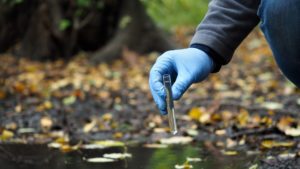The data obtained from environmental samples are important for many reasons. We use it to determine the extent of contamination, possible remediation processes, and monitoring treatment efficacy. Quality assurance measures help ensure your environmental sampling data are scientifically sound and legally defensible so you can be confident making data-based decisions.
Here’s ten considerations to protect your sampling protocol.
Coordinate with the Laboratory
Before collecting a single sample, contact the laboratory. Pre-sampling coordination with the laboratory will help ensure that you’ll get the best results possible. At a minimum, ask these three questions.
Can the laboratory perform the analyses you are requesting?
If you have a project-specific analyte list and/or required reporting limits, relay this information to the lab. They may be able customize an analyte list to meet your needs. Otherwise, they will provide their routine testing which may not give you the data you need. If your samples will require analysis at a couple of dilutions to meet your action limits, make it clear you expect the lab to do this and provide them with analyte concentration ranges.
Can the laboratory meet your required timeframe?
Never assume an expedited turnaround request stated on the chain of custody will be honored. Always get approval in advance. Coordinate the sampling schedule with the lab when you are requesting analytes with a hold time of ≤48 hours. If you collect nitrate samples on a Friday and deliver them to the lab late in the afternoon, the lab may not have staff available to perform the analysis on Saturday.
Does the laboratory have all the required federal or state laboratory certifications?
Many states have a laboratory certification or licensure program. Additionally, federal projects may require DOD ELAP or NELAC certification. Do not assume that because the lab’s website states it has the required certification that it includes the analyses your project requires. Most programs certify on a method-by-method basis and the lab may have chosen not to include a method you require. Also, make it clear that any subcontracted lab must also have required certifications.
Sample Collection
The cliché “garbage in garbage out” is true. Make sure your sampling plan is designed to achieve your data quality objectives. Before heading out in the field make sure you have a sufficient supply of the correct sample containers and that they contain any method required preservative. The samples must be representative of the site and as homogenous as possible. Eliminate potential sources of contamination while collecting samples. For example, keep the generator as far away as possible from the sample site, use proper decontamination procedures if reusing sampling equipment, and make sure anyone collecting samples refrain from the use of body spray/perfume when collecting volatile organic analytes (VOAs). If sampling for PFAS, EPA has a list of supplies and substances that cannot be used when sampling.

Verify Sample Receipts & Analyte Testing
Some laboratories provide sample receipt information. If this is available, it behooves you to review it.
First, check the sample ID’s. IDs handwritten in field may not be completely legible and prone to error when the field IDs are manually entered into the laboratory information management system (LIMS). I work on a project that submits the same samples with the same IDs every month and has done so for many years. At least four times a year I must get a “5” changed to an “S” or a zero changed to “O”. It’s much easier to have any required changes made up front rather than having to have a final report revised.
Second, check to see that your samples are logged in for the requested analyses. Some labs provide the tests as well as each tests analyte list and reporting limit. If provided, review to make sure you’re getting what you need. Again, it is always easier to get any issues resolved as soon in the process as possible. You may be able to add a missing metal after you receive your report but getting a volatile analyte added may not be possible. Do not assume that just because you have an ongoing project the lab will get everything correct when logging into their LIMS.
If you did not receive sample receipt information prior to receiving the report, make sure the sample IDs, sample dates, and times are correct once it is received. Make sure all your requested analytes are reported. Review any sample receipt information. This may be as simple as writing the cooler temperature on the chain of custody or the report may include a sample receipt checklist. Unacceptable soil vapor container pressures should be identified.
Next, look at the report’s case narrative. The case narrative varies from lab to lab. It may be a statement that there were no issues except those indicated by data qualifiers or it may be a multi-page list of all items that did and did not meet method and/or laboratory criteria. Keep this information in mind while reviewing the rest of the report.
Data that does not meet established laboratory criteria must be qualified. Unfortunately, qualifiers are not consistent. High laboratory control standard recovery would be qualified L1 for AZ work, *+ in a report from a lab in CA, and “A” in a report from a TX lab. Make sure you are familiar with the lab’s qualifier nomenclature. This is particularly important if a detailed case narrative is not provided.
Preservation Procedures
Many analyses have specific sample preservation requirements. The most common requirement is that samples be held at 0 – 6oC from the time of collection. If sample receipt information indicates the temperature was above this range, compare the time of sampling to the sample receipt time. A good rule of thumb is if the samples are on ice and received within 8 hours of sampling there is no impact on the data. If the samples were collected the previous day and the temperature is above 6oC, the results will be impacted and may not be accepted by the customer/regulatory agency.
Another common preservation issue is samples with a pH >2 in VOA vials. Advise the lab to check the vials’ pH as soon as possible when you are sampling liquid with a high pH or you know from experience has a have strong buffering capacity. EPA allows VOA samples to be analyzed by method 8260 within 7 days of sampling without preservation; however, VOA vial pH verification takes place at the time of analysis and that may be >7 days from sampling.
Sample Hold Time
Method hold times range anywhere from 15 minutes of sampling (e.g., ferrous iron) to 6 months (e.g., lead). Any analysis past hold time will be considered estimated. The usability of the data will depend on its end use. If it is part of ongoing monitoring, the results line up with historical data, and you will be collecting samples on a routine schedule the data may be usable. The data may not be usable if they are being used to demonstrate compliance with a remediation goal. The EPA states to reject any non-detects when samples were analyzed outside hold time and not properly preserved.
Blanks
Check all blanks for any detected analytes. This includes the laboratory method blanks along with all sampling blanks you submitted. Laboratory method blanks go through the same preparation and analysis steps as your samples and can demonstrate that the lab did or did not introduce contamination. The sampling blanks including equipment blanks, field blanks, and passive diffusion bag blanks will indicate the possibility of sample contamination during collection.
Compare the sample results with those of all associated blanks. If the analyte detected in the blank is not detected in the sample- no further action is required. If an analyte is detected in a blank the general rule of thumb for evaluating associated samples is concentrations greater than 10 times that found in the blank are not impacted. Concentrations in samples less than 10 times that in the blank should be qualified as estimated. Normally, if the method blank is involved the lab will reanalyze a sample. If it is a field blank, review sampling procedures, determine the source, and take corrective action.
Laboratory Control Sample / Laboratory Control Sample Duplicate
The LCS/LCSD consist of a blank matrix, spiked with a known amount of target analytes, and taken through all method and preparation steps. They are used to demonstrate batch precision and accuracy of the analysis.
A quick word on laboratory acceptance criteria. Some methods specify recovery and relative percent difference (RPD), but many organic methods require the lab to establish limits based on historical data. These limits can be quite wide. A comparison of three lab’s limits for dichlorodifluoromethane showed 27% – 154%, 29% – 150%, and 51% -149%. If your Quality Assurance Project Plan (QAPP) requires tighter limits you will need to take a close look at results, most labs will not qualify data based on your specific limits.
- If the percent recovery of an analyte in the LCS/LCSD is greater than acceptance criteria detected, concentrations of the affected analytes should be considered estimated, biased high
- If the analyte is not detected in the sample, there is no impact
- If recovery is below criteria, the affected analyte should be qualified as estimated, biased low, in all associated samples
- Data should be rejected when the LCS/LCSD recovery is <10% of criteria
- If the RPD is above criteria, detected concentrations of the affected analyte in the associated sample should be qualified as estimated, non-detects in the samples are not impacted
Matrix Spike / Matrix Spike Duplicate
The MS/MSD is similar the LCS/LCSD, using a batch sample instead of a blank matrix. They are evaluated in the same manner as the LCS/LCSD except that for organic analyses, the only data qualified is that for the sample used as the MS/MSD source. For inorganic analytes, all batch samples from the same site are qualified. MS/MSD results prepared using a non-project sample as the source have no impact on your samples.
Surrogates
Some organic methods require the addition of surrogates. Surrogates are deuterated compounds that indicate sample preparation and analysis efficiency. Surrogates are not assigned to any specific analytes, so any data qualification applies to all the analytes reported.
- <10% surrogate recovery: all analytes detected in the sample should be qualified as estimated low bias and any non-detects should be rejected
- >10% surrogate recovery but below the lower acceptance limit: all results are qualified as estimated, low bias
- Surrogate recovery above acceptance criteria: non-detects are not impacted and detected concentrations are qualified as estimated, high bias
Other Quality Control Measures for Environmental Sampling Data
Some laboratories will provide information on other steps taken to ensure data accuracy. These include instrument calibration information, internal standard recoveries, continuing calibration verification standards and blanks, etc. These are not part of the requirements for EPA Stage 2A verification.
Data Verification Resources
For more information on data verification and validation consult:
- National Functional Guidelines for Inorganic Superfund Methods Data Review
- National Functional Guidelines for Organic Superfund Methods Data Review
- EPA Guidance for Labeling Externally Validated Laboratory Analytical Data for Superfund Use
This information will assist you in determining if the results in your laboratory report are scientifically sound and legally defensible. Keep in mind that this information can be used to verify data. It is a review equivalent to EPA Stage 2A “A verification based on completeness and compliance checks of sample receipt conditions and ONLY sample-related QC results”. This is different than data validation which involves the review of all preparation and analytical raw data.
Data integrity is critical when facing environmental compliance pressures, litigation, or simply proactively managing your environmental liabilities. You want to make decisions guided by science and based on facts. Our engineering and hydrogeology experts deliver the high-quality reports, presentations, and supporting documentation critical in communicating with regulators, the public, and your management.
If you want peace of mind when it comes to your environmental sampling data, contact us today https://www.hargis.com/contact/.
About the Author

Mary Tyer
Environmental Chemist
Quality Assurance Manager
Hargis + Associates, Inc.
mtyer@hargis.com
Mary has extensive experience in working for and with environmental laboratories. As a Quality Assurance Manager, she was responsible of reviewing data for method adherence, usability and defensibility and has carried that responsibility to her role with Hargis and Associates. Her laboratory experience has made her a great resource for analytical method selection and requirements along with individual state’s requirements for laboratory accreditation and reporting. She has worked closely with laboratories and regulatory agencies to resolve data issues. Mary also has considerable experience working for private and public utilities and has in-depth knowledge of drinking, surface, and wastewater testing and reporting requirements.

